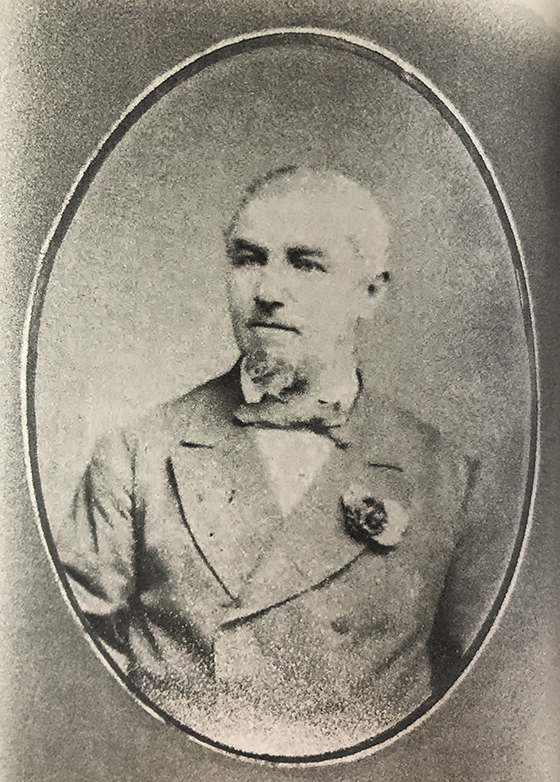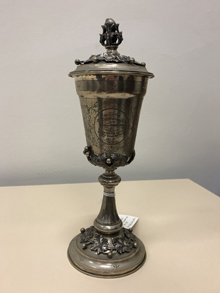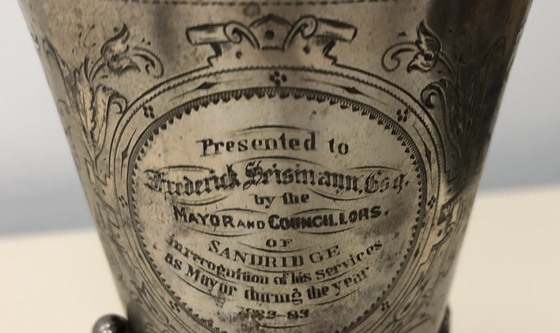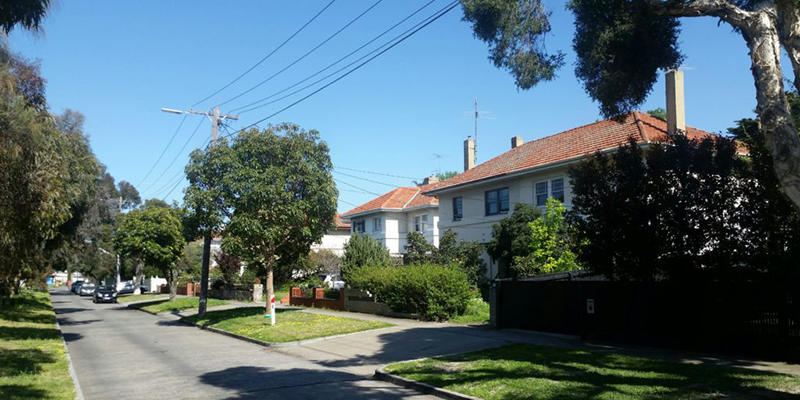Seisman Street
Seisman Street runs between Dow Street and Esplanade West near Liardet Street. Originally known as Clark Street, but unproclaimed as an official street, Sandridge Council at their meeting on Thursday 22 November 1883 approved that it be renamed Seisman Street, after the immediate past Mayor, Cr Frederick Seismann. The reasoning being that a Clark Street, already proclaimed, existed in the west of the borough. 1

At that same meeting, the Mayor at the time, Henry Beveridge Donaldson, presented Seismann with a ‘very handsome silver goblet’ inscribed :-
“Presented to Frederick Seisman, Esq, by the Mayor and Councillors of Sandridge in recognition of his services as Mayor during the year 1882-3.” 2
Which raises a question. Is it Seismann or Seisman?
Certainly the street is Seisman, which appears to fit the intention of Council, of which Seismann was an elected Councillor and was present at the meeting when the name was changed (although he may have excused himself from that specific part of the deliberations), but the majority of contemporary newspaper reports favour the double ‘n’ version. Rightly or wrongly, we have adopted that version for this article too.
Carl Frederick Julius Seismann was born in Germany around 1827 and came to Sandridge in 1849-50, working as a third officer on a German vessel before jumping ship in Port Phillip Bay. He established a business as a cab proprietor and mail contractor with stables at the beach end of Bay Street. 3 He built the Royal Mail Hotel at 20 Bay Street, now known as The Local, in 1872 4 and later became owner the Australian Eleven Hotel further along Bay Street. After selling the hotels, he lived in retirement in Station Street. 5
Seismann took great interest in the affairs of the Borough. He helped form the South Suburban Building Society and was its first President. 6 He was elected to Council in August 1878 and served until August 1885. As we saw before, he served as Mayor in 1882-3 , elected after the resignation of Frederick Thomas Derham. 7
In 1880 Seismann formed the Sandridge Volunteer Fire Brigade with a reel house in Stokes Street. The keys were kept at Mrs Taylor’s at 80 Stokes Street. 8
Seismann was the first President of the Bowling Club when it was formed in 1883, serving until 1891. 9 He followed Thomas Swallow as the second President of the Football Club probably drawn to football through his son, John, who was a player during the club’s junior days. 10 As President from 1879 to 1886 he oversaw the club change its name from the Sandridge Alma FC aka Sandridge FC to Port Melbourne FC in line with the renaming of the municipality in 1884 11, and the transformation from junior club to senior club in the VFA in 1886. 12 He was also involved in the formation of the local tennis club 13.
Frederick Seismann died on Monday 7 November 1892 aged 65. 14
Postscript

The ‘very handsome silver goblet‘ (see right) presented to Cr Frederick Seismann is held as part of the City of Port Phillip’s Heritage Collection.
It is actually silver-plated but is indeed, very handsome.
It is interesting to note that despite what was reported in the newspapers at the time, the inscription on the cup includes the second ‘n’ in Seismann’s name (see below). This leads me to think that Seismann was happy for his name to be spelt either way but when it came to naming a street after him, he preferred, as Pat Grainger has suggested in her comment below, the anglicised version and hence we have Seisman Street.

Keen observers will have noticed there is a Seisman Place in Albert Park.
When Seisman Street was first proclaimed in 1883, it straddled the lagoon (now Lagoon Reserve) restarting at Esplanade East on the other side. That portion of Seisman Street has been removed in relatively recent times but it’s existence is recognised with Seisman Place on the other side of Pickles Street.
References:
1 1883 ‘MUNICIPAL INTELLIGENCE.’, The Argus (Melbourne, Vic. : 1848 – 1957), 23 November, p. 9. , viewed 05 Jun 2019, http://nla.gov.au/nla.news-article11835944
2 1883 ‘FRIDAY. NOVEMBER 23, 1883’, Record (Emerald Hill, Vic. : 1881 – 1954), 23 November, p. 2. , viewed 06 Jun 2019, http://nla.gov.au/nla.news-article120728617
3 1892 ‘DEATH OF MR. SEISMANN.’, Standard (Port Melbourne, Vic. : 1884 – 1914), 12 November, p. 2. , viewed 06 Jun 2019, http://nla.gov.au/nla.news-article165170767
4 ‘Chartered Scoundrels: A Brief History of Port Melbourne Hotels’ (Port Melbourne Historical and Preservation Society, Australia : 2007) Pat Grainger, p. 79.
5 1892 ‘DEATH OF MR. SEISMANN.’, Standard (Port Melbourne, Vic. : 1884 – 1914), 12 November, p. 2. , viewed 06 Jun 2019, http://nla.gov.au/nla.news-article165170767
6 1889 ‘Advertising’, Standard (Port Melbourne, Vic. : 1884 – 1914), 19 October, p. 1. (SUPPLEMENT to THE “STANDARD”), viewed 05 Jun 2019, http://nla.gov.au/nla.news-article164424492
7 ‘A History of Port Melbourne’ (Oxford University Press, Melbourne : 1983) Nancy U’Ren and Noel Turnbull, p. 273, 280.
8 ‘Fire in the Borough’ (H Merreck-Andrews, Mordialloc, Vic. : 2007) Shirley A Videon, p. 35.
9 1932 ‘Port Melbourne Bowling Club’, Record (Emerald Hill, Vic. : 1881 – 1954), 24 September, p. 6. , viewed 05 Jun 2019, http://nla.gov.au/nla.news-article164457918
10 ‘In Safe Hands – Presidents of the Port Melbourne Football Club’ (Eucalyptus Press, Albert Park, Vic. : 2011) Terry Keenan, p. 23-25.
11 ‘Kicking Into the Wind – A history of the formative years of the Port Melbourne Football Club 1874-1917’ (Walla Walla Press, Petersham, NSW. : 2004) Terry Keenan, p. 14-15.
12 ‘In Safe Hands – Presidents of the Port Melbourne Football Club’ (Eucalyptus Press, Albert Park, Vic. : 2011) Terry Keenan, p. 23-25.
13 1884 ‘BANQUET TO F. SEISMANN, Eso.’, Standard (Port Melbourne, Vic. : 1884 – 1914), 30 August, p. 3. , viewed 06 Jun 2019, http://nla.gov.au/nla.news-article164932592
14 1892 ‘DEATH OF MR. SEISMANN.’, Standard (Port Melbourne, Vic. : 1884 – 1914), 12 November, p. 2. , viewed 06 Jun 2019, http://nla.gov.au/nla.news-article165170767



6 Comments
Pat Grainger
Seismann was a Seismann, but sometimes dropped off the second n as did many German families including my own.
He also in the late ’80s owned other hotels beyond the railway, the Albion and the Clare Castle. And led the anti-temperance association, and was one of a number who supported the questionable Rev. Platt at Holy Trinity when the congregation wanted him gone.
A most interesting fellow.
Also interesting, that silver platter: with a new mayor nearly every year and the council relatively short of funds (spending on Council Chamber construction and unable to afford a clock for the clocktower), it might hint of the extravagant 1880s boom before the 1890s depression, as I wonder how many mayors actually scored silver?
David Thompson
Thanks Pat,
That could explain how the single ‘n’ version is what has been passed down in the street name and why there was no correction by Seismann at the time. Perhaps it was his preference.
Margaret Bride
I wonder if there is a connection between him ‘jumping ship’ and the network of German connections in Port Melbourne who assisted German’s who wanted to do that, hiding them form the authorities and helping them move north to the Wimmera if that was what they wanted?
Janet Bolitho
That is a possibility you might explore Margaret?
Stephen Stuart
Lots of interesting glimpses here of my great-great-grandfather Fred. He was double-n for all official purposes. The story of him being a ship’s officer ‘which he left in the bay’ explains why he is not recorded as a regular German migrant. I guess he may have been on the ship Emmy, commissioned by William Westgarth, which arrived in Port Phillip on 19 Dec 1849 – altho I have not found the crew list. But he did go on to Adelaide where he married Stientje Ralfs. She had arrived there with her married sister aboard the ship Australia – her name in S A Register garbled as Stintze Balls. Sensibly enough she was called Christina in Australia. The marriage didn’t last. Fred moved out of Esplanade West in the 1870s and probably cared little for Seisman Street.
Barbara Hocknell
Carl Frederick Seismann is the 2x great grandfather of my husband (John Hocknell – now deceased) he had another family with an Elizabeth Denes? unsure of name – they had a daughter Hilda who married a Russell Hocknell (another Mariner from England) and moved to Sydney and had 2 children Russell( husband’s grandfather) and daughter Hilda( died unmarried). Russell had 2 boys- John(my husband) and Russell. You must be related to my husband’s family.